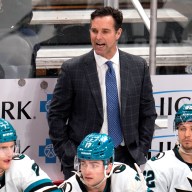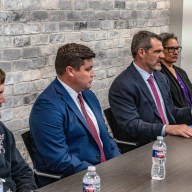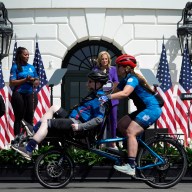CALGARY – Women’s hockey in Canada is no longer a wilderness in which the most talented have to make their way to the world stage alone.
The Canadian players who reached the final of the inaugural women’s world under-18 hockey championship Saturday have had a hockey machinery behind them that their predecessors could only dream of.
“When you look at the support and mechanisms in place for the young players now, there is absolutely no excuse for a talented player not to succeed,” head coach Melody Davidson observed prior to the final. “No excuse, other than the decisions they make.
“Our older players, they had to do that without any of the support these guys get.”
To compare, national team veteran Danielle Goyette didn’t start playing hockey until she was 15. She played pickup hockey on a women’s team and she was coached by the husband of a teammate.
Until she started playing organized hockey at age 30, her teaching came from watching the Montreal Canadiens on television and then heading to an outdoor rink to try and emulate her hero Guy Lafleur.
Natalie Spooner, a forward on the under-18 team, started playing hockey at age four and by age seven she was part of the Durham West Girls Hockey Association in Ontario, working her way from atom up to midget.
The 17-year-old from Toronto now plays about 30 games, plus tournaments, in a 17-team province-wide league.
“In 1990, they had players just like us probably and they had to progress by themselves,” Spooner said.
There was a time when most goals in women’s hockey were scored from within two metres of the net, but Canada’s shots from the blue-line at this under-18 championship have been high, hard and on target.
The Canadians were creative with the puck and moved it at high speeds.
All but two of the them were born in 1990, which was the first year the International Ice Hockey Federation held a women’s world hockey championship.
But just as significant was the introduction of women’s hockey to the Canada Winter Games in 1991, which spurred the provincial hockey associations into developing girls’ hockey.
Hockey Canada added a women’s under-22 team and now an under-18 squad to supplement the national team and those steps are changing the face of the Canadian women’s team.
“When you look at the average age of our senior team, it comes down every year,” observed Julie Healy, Hockey Canada’s director of female hockey.
The under-18 team intersects with the work of the branches, who identify players to represent their provinces at the national under-18 championship and Canada Games.
“Their branch programs are extremely well developed and that is the basis upon which we do everything,” Healy said. “They do all the legwork for us and we pick the cream of the crop for a short period of time.”
Hockey Canada’s budget for the women’s under-18 team in 2007-08 is $400,000 and that doesn’t include this world championship.
It covers a May conditioning camp, a summer on-ice camp, a three-game series against the U.S. in August, fitness testing and supervised training.
The under-18 team had all the trappings during the tournament of a national men’s and women’s team: two assistant coaches, a video coach, goaltending consultant, strength and conditioning coach, physiotherapist, psychologist, team doctor.
“It’s like you are a superstar,” marvelled forward Camille Dumais of Beaconsfield, Que. “Sometimes you wonder what NHL people do. Our only job is to go out on that ice and perform at our best.”
The number of registered females playing hockey in Canada has skyrocketed from 8,146 in 1990 to 73,791 now.
That growth doesn’t happen without a change in attitude and for the players on the under-18 team, hockey has been a normal part of growing up.
They’ve watched women play the sport on television in world championships and Olympics and it’s no longer seen as the oddity it once was.
“This is our first generation of hockey players that have grown up with women on the international stage,” Healy pointed out. “For them, putting skates on from the first day they can skate and playing hockey, it hasn’t been unusual.”
But Davidson, who coached Canada to Olympic gold in 2006, still feels a lack of acceptance of the sport from some quarters.
“There are still so many naysayers and I run into them every day,” she said. “I’m sure there’s many of them that haven’t bothered to attend the games that are criticizing women’s hockey and there’s many that are coming saying it’s not good enough.
“I don’t think that’s so much about hockey. It’s just society.”
















